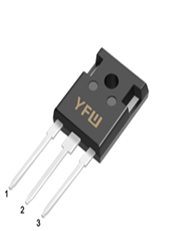Date:2025-05-16 Categories:Product knowledge Hits:423 From:Guangdong Youfeng Microelectronics Co., Ltd
When a forward voltage is applied across the
Ultra - fast recovery diodes (anode positive with respect to the cathode), the potential barrier at the p - n junction is reduced. This allows the majority carriers to flow across the junction. In the p - type region, holes move towards the n - type region, and in the n - type region, electrons move towards the p - type region. As the carriers cross the junction, they recombine. The recombination of electrons and holes releases energy in the form of heat. During this forward - conducting state, the UFRD exhibits a relatively low voltage drop (forward voltage,
), which is a key parameter affecting the power loss in the circuit. For example, in a typical silicon - based
Ultra - fast recovery diodes, the forward voltage drop may range from 0.6 V to 1.2 V depending on the current level and device design.
4. Reverse - Recovery Process
The reverse - recovery process is where
Ultra - fast recovery diodes truly distinguish themselves from conventional diodes. When the applied voltage across the diode is suddenly reversed (from forward - bias to reverse - bias), in a conventional diode, there is a significant delay before the diode can block the reverse current. This delay is due to the presence of stored minority carriers in the semiconductor material.
In the case of
Ultra - fast recovery diodes, during the forward - conducting state, minority carriers are injected into the drift region. When the voltage is reversed, these stored carriers need to be removed or recombined quickly for the diode to start blocking the reverse voltage.
Ultra - fast recovery diodes achieve fast reverse recovery through several mechanisms. Firstly, the lightly doped n - drift region mentioned earlier reduces the carrier storage effect. The lower carrier concentration in this region means there are fewer stored carriers to be removed during reverse - bias. Secondly, special doping techniques are used to introduce recombination centers. These recombination centers accelerate the recombination of electrons and holes, thereby reducing the time it takes for the stored carriers to disappear. As a result, the reverse recovery time (trr) of
Ultra - fast recovery diodes is much shorter compared to conventional diodes. For example, while a conventional diode may have a reverse recovery time in the range of several hundred nanoseconds to microseconds,
Ultra - fast recovery diodes can have atrr as low as tens of nanoseconds or even less.
5. Key Parameters Affecting the Principle
5.1 Reverse Recovery Time (trr)
As discussed,trris a critical parameter. It determines how quickly the diode can switch from the conducting state to the blocking state when the voltage polarity changes. A shorter trr allows the
Ultra - fast recovery diodes to operate at higher frequencies without significant power losses due to reverse - recovery current spikes. These current spikes can cause electromagnetic interference (EMI) and increase power dissipation in the circuit.

